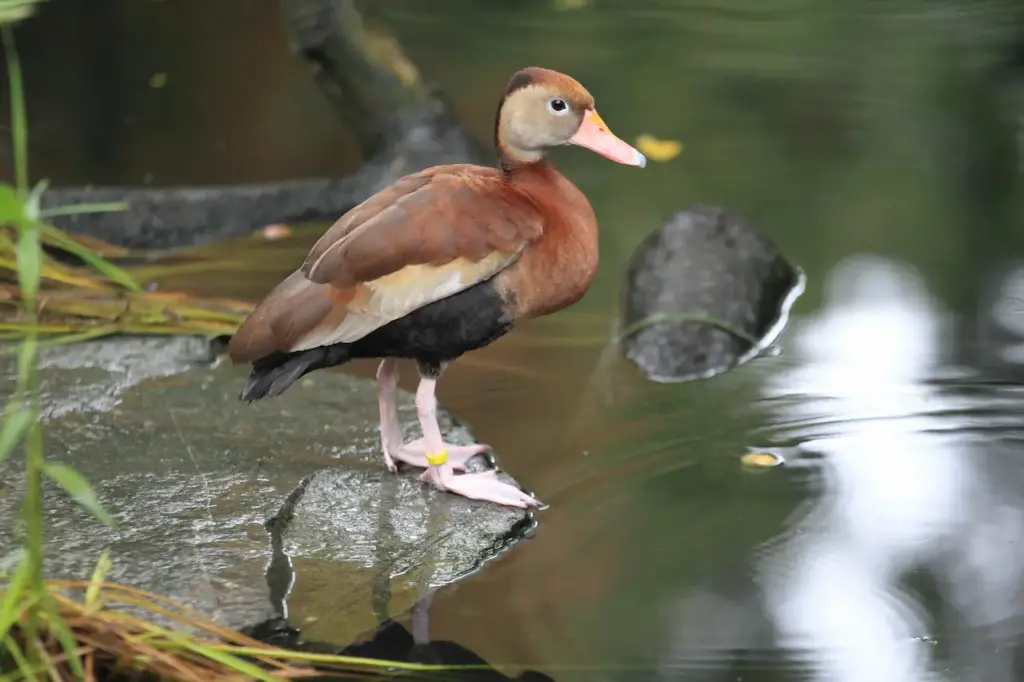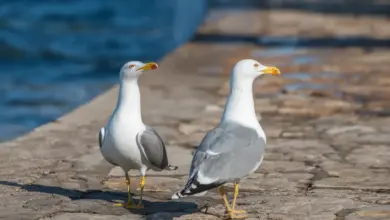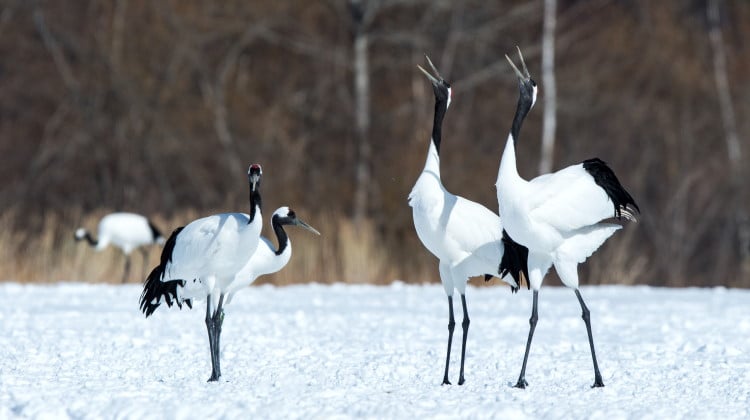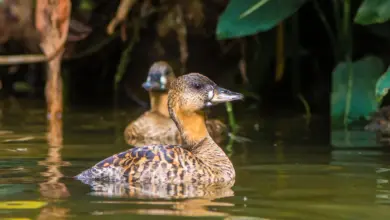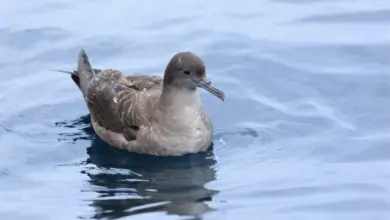The Black-bellied whistling duck (Dendrocygna autumnalis), formerly also called Black-bellied Tree Duck, is a whistling duck that breeds from the southernmost United States and tropical Central to south-central South America.

In the USA, it can be found year-round in parts of southeast Texas, and seasonally in southeast Arizona, and Louisiana’s Gulf Coast. It is a rare breeder in such disparate locations as Florida, Arkansas, Georgia, and South Carolina.
It is widely known as “pijije” (also “pixixi” or “pichichi”), “chiriría” or “sirirí” in Latin America, though this can also refer to other whistling ducks and a qualifier such as “ala blanca” or “aliblanco” (“white-winged”) is usually added to signify this species. In Mexico, it is also called pato maízal (“cornfield duck”) due to its habit of visiting such fields after harvest. And since it is one of only two whistling duck species native to North America, it is occasionally just known as “the whistling duck” in the southern USA.
It is an unusual species among North American waterfowl. With its long legs, peculiar appearance and odd habits, it was described by one early American ornithologist as “most un-duck-like”. Its numbers are increasing in North America.
Description
The Black-bellied Whistling-duck is 19-21 in (48-53 cm) long.
It has a long red bill, long head and longish legs, pale grey head and mostly grey-brown plumage. The belly and tail are black, and the body plumage, back of the neck and cap are a rich chestnut brown. The face and upper neck are grey, and they sport a thin but distinct white eye-ring. The extensive white in the wings is obvious in flight, less so on the ground; it is formed by the secondary remiges while the primaries (longest wing feathers) are black; the wing-coverts are brown.
Males and females look alike; juveniles are similar but have a grey bill and less contrasting belly.
Due to its unique appearance, this species is almost unmistakable. With an upright stance, long pink legs, and long neck, adult black-bellied whistling-ducks are unlikely to be confused with any other bird within their range. The wing bar is in fact unique among living whistling-ducks. But when on the ground, it may be hard to discern or look like the light flanks present in many of these waterfowl. The Fulvous Whistling-duck (D. bicolor) is the only sympatric whistling-duck that shows such a whitish flank stripe however, and it differs from the Black-bellied by having dark wings and a lighter belly rather than the other way around. Juvenile D. autumnalis are quite similar to young of the White-faced Whistling-duck (D. viduata), which have a darker bill and no white wing patch; even when sitting they never seem to show white along the sides, as their thin white vertical barring on the black flanks is very indistinct.
As the name implies, these are noisy birds with a clear whistling waa-chooo call.
Subspecies
There are two subspecies, which intergrade in Panama:
- Northern Black-bellied Whistling-duck, Dendrocygna autumnalis autumnalis – Southern USA to Panama
- Larger, with a brown breast and upper back
- Southern Black-bellied Whistling-duck, Dendrocygna autumnalis discolor – Panama to Paraguay and adjacent regions
- Smaller, with grey breast and upper back
Black-bellied Whistling Duck Standing Near the Water
Ecology
It is a common but wary species. It is highly gregarious, forming large flocks when not breeding, and is largely resident apart from local movements.
It usually nests in hollow trees. The habitat is quiet shallow freshwater ponds, lakes, and marshes, cultivated land or reservoirs with plentiful vegetation, where this duck feeds mainly at night on seeds and other plant food. Tree-lined bodies of water are of particular value and as the old common name suggests, they are quite fond of perching in trees. Also, tree cavities provide nesting sites.
This species can also be seen “loafing” (doing nothing in particular except hanging around and socializing) in flocks on golf courses and other grassy areas near suitable waterways.
Diet
Feeding often occurs nocturnally, but they can be encountered eating at any hour of the day. Black-bellied whistling-ducks ingest a wide variety of plant material, but also consume arthropods and aquatic invertebrates when available.
They often feed on submerged vegetation by wading through shallow water. As its Mexican name implies, it is commonly seen gleaning recently-harvested fields for leftover seed and invertebrates brought up by the harvesters disturbing the soil.
Movements
It is mainly non-migratory. Birds in the extreme northern portions of their range (Arizona, Louisiana, and parts of Texas) move south in winter. At the heart of their range, there is a tendency to travel in flocks over the winter months, though this behavior is not a true long-range migration but rather local dispersal.
Reproduction
It is quite unique among ducks in their strong monogamous pair-bond. Its pairs often stay together for many years, a trait more often associated with geese and swans. Both parents share all tasks associated with the raising of young, from incubation to the rearing of ducklings.
The ducks, primarily cavity nesters, prefer the confines of a hollow tree, but will nest on the ground when necessary. They also make use of chimneys, abandoned buildings, or nest boxes, the latter having been increasingly provided to them over recent decades, especially in southeast Texas and Mexico.
Ducklings leap from nest cavities within two days of hatching, can feed themselves immediately, and stay with the parents for up to eight weeks.
Status and conservation
This species is not considered to be of conservation concern by the IUCN and the National Audubon Society; its global population is estimated at 1,550,000 birds.
Black-bellied Whistling-duck populations are currently stable or increasing. It has expanded its range significantly in the latter half of the 20th century, and has benefited in recent years from the placement of nest boxes across key portions of the north of its range. Breeding Bird Survey and Christmas Bird Count data both confirm that populations of this species have increased significantly over the past 30 years.
The existence of healthy coastal wetlands greatly benefits Black-bellied whistling-ducks. In past years, over-hunting was a serious concern, largely due to the species’ relatively docile nature. Current populations, however, seem to be secure enough to sustain hunting at the present levels, which are lower than in the past and mostly aimed at preventing large numbers of these birds gathering on fields where they may harm crops.
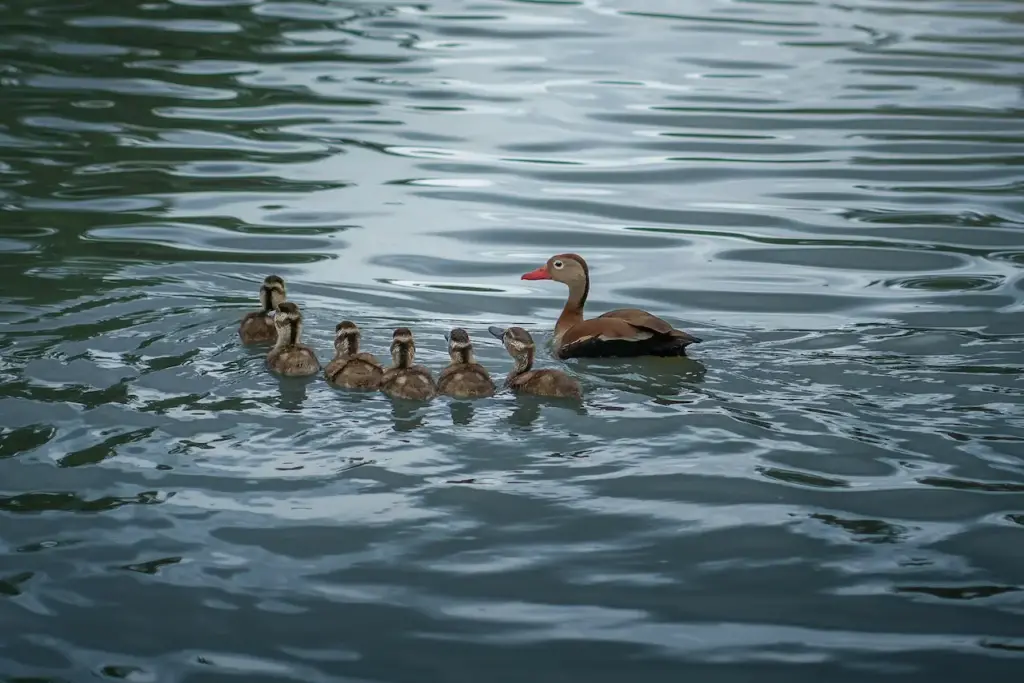
Copyright: Wikipedia. This article is licensed under the GNU Free Documentation License. It uses material from Wikipedia.org … Additional information and photos added by Avianweb.
Diet / Feeding:
Ducks feed on larvae and pupae usually found under rocks, aquatic animals, plant material, seeds, small fish, snails, and crabs.
Instead of “teeth,” ducks have serrations (saw-like edges) on their bills that allow them to filter food out of the water.
Feeding Ducks …
We all enjoy these beautiful birds and many of us offer them food to encourage them to come over and stay around – and it works! Who doesn’t like an easy meal!
However, the foods that we traditionally feed them at local ponds are utterly unsuitable for them and are likely to cause health problems down the road. Also, there may be local laws against feeding this species of bird – so it’s best to check on that rather than facing consequences at a later stage.
- Foods that can be fed to Ducks, Geese and Swans to survive cold winters and remain healthy when food is scarce in their environment.
Please note that feeding ducks and geese makes them dependent on humans for food, which can result in starvation and possibly death when those feedings stop. If you decide to feed them, please limit the quantity to make sure that they maintain their natural ability to forage for food themselves – providing, of course, that natural food sources are available.
Please Note: The articles or images on this page are the sole property of the authors or photographers. Please contact them directly with respect to any copyright or licensing questions. Thank you.

